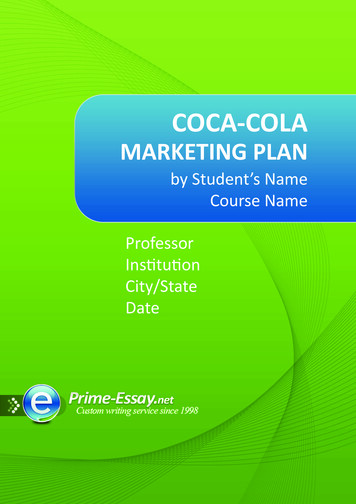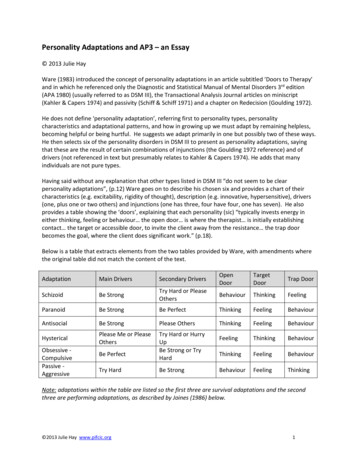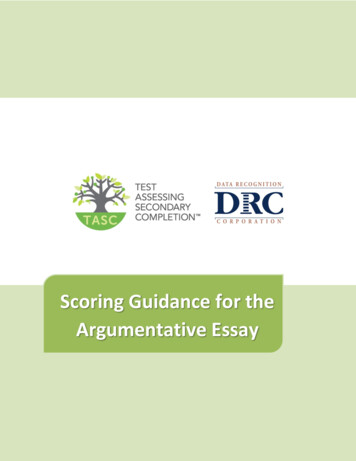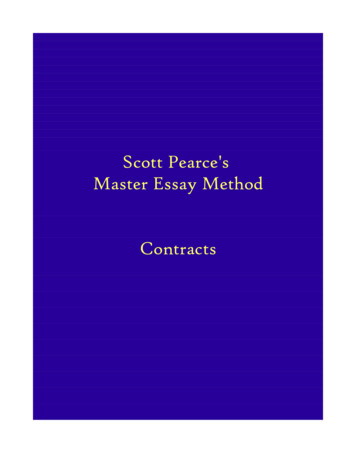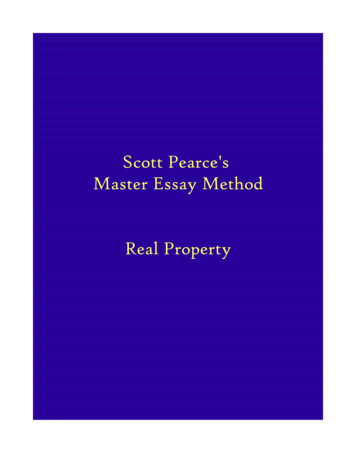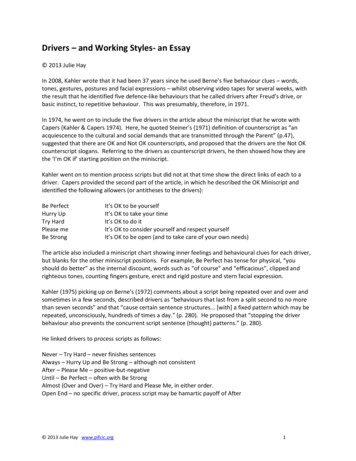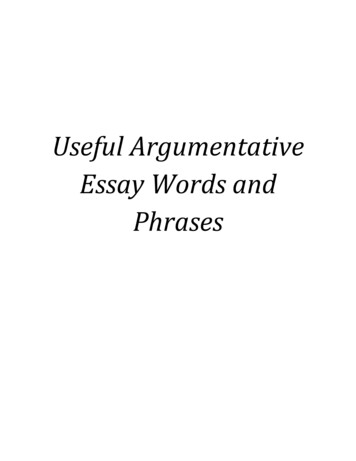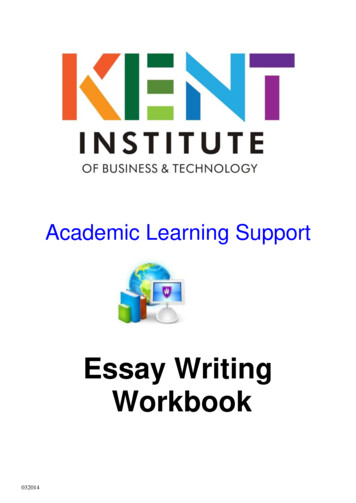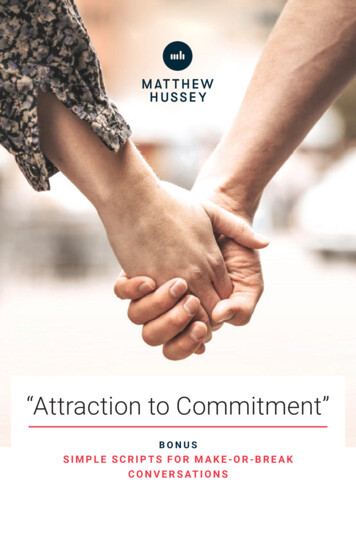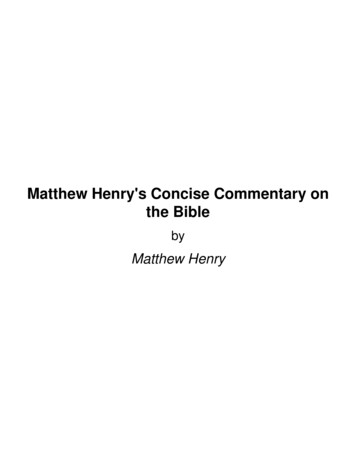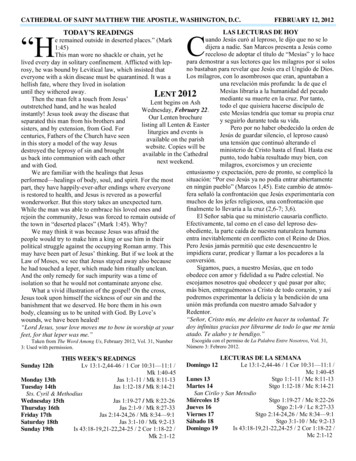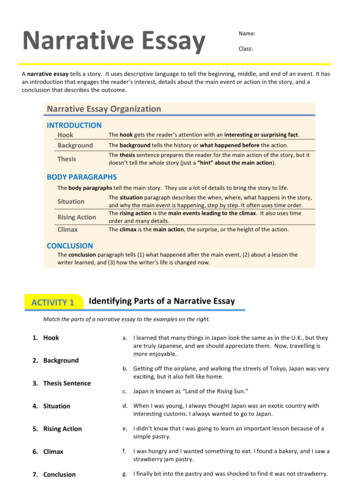
Transcription
Narrative EssayName:Class:A narrative essay tells a story. It uses descriptive language to tell the beginning, middle, and end of an event. It hasan introduction that engages the reader’s interest, details about the main event or action in the story, and aconclusion that describes the outcome.Narrative Essay OrganizationINTRODUCTIONHookBackgroundThe hook gets the reader’s attention with an interesting or surprising fact.The background tells the history or what happened before the action.The thesis sentence prepares the reader for the main action of the story, but itdoesn’t tell the whole story (just a “hint” about the main action).ThesisBODY PARAGRAPHSThe body paragraphs tell the main story. They use a lot of details to bring the story to life.SituationRising ActionClimaxThe situation paragraph describes the when, where, what happens in the story,and why the main event is happening, step by step. It often uses time order.The rising action is the main events leading to the climax. It also uses timeorder and many details.The climax is the main action, the surprise, or the height of the action.CONCLUSIONThe conclusion paragraph tells (1) what happened after the main event, (2) about a lesson thewriter learned, and (3) how the writer’s life is changed now.ACTIVITY 1Identifying Parts of a Narrative EssayMatch the parts of a narrative essay to the examples on the right.1. Hook2. Background3. Thesis Sentencea. I learned that many things in Japan look the same as in the U.K., but theyare truly Japanese, and we should appreciate them. Now, travelling ismore enjoyable.b. Getting off the airplane, and walking the streets of Tokyo, Japan was veryexciting, but it also felt like home.c. Japan is known as “Land of the Rising Sun.”4. Situationd. When I was young, I always thought Japan was an exotic country withinteresting customs. I always wanted to go to Japan.5. Rising Actione. I didn’t know that I was going to learn an important lesson because of asimple pastry.6. Climaxf.7. Conclusiong. I finally bit into the pastry and was shocked to find it was not strawberry.I was hungry and I wanted something to eat. I found a bakery, and I saw astrawberry jam pastry.
Narrative Essay Organization: My First Japanese PastryParagraph1INTRO23Hook Japan is known as “Land of the Rising Sun.”Background I always thought Japan was an exotic country withinteresting customs. I always wanted to go to Japan.Thesis Eating a pastry taught me an important lesson.SituationBODYRising ActionClimax4Matthew Barbee, 2016CONCLUSION Getting off the airplane, and walking the streets of Tokyo,Japan was very exciting, but it also felt the same as home. I was hungry and I wanted something cheap and delicious I found a bakery. I saw a strawberry jam pastry like back home. I bit into the pastry and was surprised to find it was notstrawberry jam. I began to like sweet bean paste. I learned that many things in Japan look the same as inthe U.K., but they are truly Japanese, and we shouldappreciate them. Now, travelling is more enjoyable.2
ACTIVITY 2Reading a Student EssayRead the essay. Respond to the essay by answering the following questions.My First Foreign FriendMy first foreign friend broke my heart. However, before I could have a foreign friend, I needed totravel aboard first. I have always wanted to go abroad and make friends around the world. Last winter, Iwas able to study abroad for four weeks in Toronto. While I was studying in Toronto, I met a Canadiangirl named Jem. She told me that she wanted to make Japanese friends, so I was happy to talk to her. Iwas also happy to talk to her because she is so beautiful. Jem is half white and half Filipino, and I hadnever seen anyone like her before. It is safe to say that I fell in love with her at first sight, but noteverything is meant to be. (115)In the beginning of our friendship, I was able to meet Jem often because we were languageexchange partners. Jem helped me study English, and I helped her study Japanese. Gradually we becamemore and more friendly, so I invited her to go out to eat dinner with me. We went to a restaurant with herfriends who also study Japanese. I talked a lot with her and her friends in English, and we ate katsudon. Itis very delicious. Having dinner together made me very happy, and I think that my language skillimproved. (100)One day, I went to watch an American football game with my Kwansei Gakuin friends. At thegame, I saw Jem with another student. I said hello, and I asked about her friend. She said “He is myboyfriend.” That is, she had a boyfriend. I was surprised, and I was disappointed in love. Furthermore,her boyfriend was also Japanese and was studying abroad like me. I was sad because of that unbelievablefact. At that moment, I thought that my experience in other country was sad. (95)At last, the day I went back to Japan, I heard from Jem by email. In her email, she wrote, “thankyou for being my friend. I want to meet you and speak in Japanese when I go to Japan this summer.’’ Heremail really made me smile. I forgot about my feelings at the football game and remembered all the greattimes I had in Toronto. Overall, I learned that life is made up of good and bad memories, but it is mostimportant to remember the good ones. (90)Total Words: 4001.Why is the background information in the introduction important to the story?2. How did the writer and Jem become friends? (What is the situation?)3. What happened before the writer’s heart was broken? (What is the rising action?)4.What broke the writer’s heart? (What is the climax of the story?)5. What did the writer learn? Was it a positive lesson or a negative lesson?Matthew Barbee, 20163
ACTIVITY 3Writing a Great HookThe hook is the first sentence of your essay. Thepurpose of a hook is to get the reader’s attention. Thereare 5 types of hooks: Shocking statementInteresting factStatisticQuestionQuoteA. Below is the introduction to a narrative essay. Read the paragraph and then underline the hook.I cannot live without pizza. If I go very long without eating a hot delicious slice ofpizza, I become sick. When I lived in the United States, I ate a whole pizza every week.But when I started living in Japan, I forgot about eating pizza. I was happy eatingdelicious Japanese foods at first, but I eventually began to crave a hot slice of bread,sauce, and cheese. After living in Japan for six months, I ordered Japanese pizza for thefirst time.1. What type of hook do you think is used?2. Why do you think a good hook is important?B. Look at the examples of different types of hooks below. Work together in a small group to write your ownhooks. The essay topic is “Japanese pizza.”HooksExamplesShockingstatementI love pizza more thanmy family.InterestingFactPizza was firstinvented in Italy, butmodern pizza haschanged a lot.StatisticThe average Americaneats 27 pizzas a year.QuestionWhat is your favoritefood in the world?Mine is pizza.QuoteWrite your own:Einstein once said,“Pizza is the mostperfect food.”Matthew Barbee, 20164
ACTIVITY 4Reading a Student EssayRead the essay. Respond to the essay by answering the following questions.My First Time CookingWhen I was ten years old, I almost died in the kitchen. One day, I was the only one home becausemy parents went to an elementary school to teach, and my big sister was staying at her friend’s house. Iwas bored, and I played video games a whole lot. In the early evening, I became hungry, but there wasnothing to eat. I looked in our refrigerator, but there was only some vegetables and medium spicy curryroux. When I saw that, I thought, “my mother can make curry easily, so I can make curry, too.” I decidedto make curry by myself, but it would be dangerous because I had never cooked anything until then. (115)At first, I started to cook some rice. Second, I cut onions, but I couldn’t stop crying for 20minutes. After I stopped crying, I cut carrots. I did well partway, but I cut my middle finger because Ididn’t fold my fingers away from the knife. I felt foolish. I almost gave up, but I continued to cook. Next,I peeled potatoes with a peeler. I thought it was safe, but I was wrong. My nail was skinned a little by thepeeler. After the vegetables, I prepared a deep pot and started to fry vegetables and chicken. However,another problem happened. Before I fried them, I forgot to grease the bottom of the pot and it burned. Imoved them from the burned pot to another one, and I started to fry them again. There were a lot ofproblems, but I completed making curry at last. (150)After I made curry, I looked at my hand, and it was all cut up. There was some adhesive tape onit, but my heart was full of accomplishment. When I ate MY curry, it was very tasty. Later, when mymother got home, she ate my curry and said, “this is so delicious.” She looked so happy, and I was sohappy, too. After that, my father came back home, and he ate my curry, too. He was surprised that I hadmade curry by myself. My parents were happy, so I wanted to cook again. (95)These days, I often cook curry and rice by myself. Now that I know how to make it properly, Ihave become much better at it. I think it is good for us to try new things. Even if if we are not perfect atfirst, we can become better and better. As they say, “practice makes perfect.” In conclusion, while my firsttime cooking was terrible, it became an invaluable memory that I will never forget. (75)Total Words: 4351. Underline the hook? A. What type of hook is it? B. Write a new hook for the essay using a different type.A.B.2. Why was the writer home alone? What is some other background information of the story?3. How three problems did the writer have when making curry?4. What was the climax of the story? (Why were the writer’s parent’s happy?)5. What did the writer learn? Was it a positive lesson or a negative lesson?Matthew Barbee, 20165
ACTIVITY 5Time AdverbsTo sequence events in a narrative essay, we use time adverbs such as then, finally, eventually, after that, later, andthen. They usually appear at the beginning of the sentence and followed by a comma.Then is an exception. It is not followed by a comma. Our train was running late. Finally, it arrived. We got on the train. Then we realized that we didn’t have money for the ticket.Identifying Time AdverbsReread the student essays, My First Foreign Friend and My First Time Cooking. List time adverbs that you find:ACTIVITY 6Subordinating ConjunctionsWe also use subordinating conjunctions to sequence events such as before, as soon as, after, when, and while incomplex sentences as connectors. Complex sentences contain a main clause (independent) and a dependentclause. The dependent clauses give extra information about the main clause, for example, where or when ithappened.Subordinating conjunctions tell when something happened. When a subordinating conjunction comes are thebeginning of the sentences, we use a comma. No comma is needed if it comes at the end.Time ClauseAfter our parents left the house,Before my brother was born,Main ClauseWe had a partyI was an only childMain Clausewe had a party.I was on only child.Time Clauseafter our parents left the house.before my brother was born.Using Subordinating ConjunctionsCombine each pair of sentences into one complex sentence. Use the subordinating conjunctions in (parentheses) to clarifythe sentence.1. People harvested apples. They cooked and stored them in glass jars. (after)2. I ate the main course. I ate my salad. (before)3. She applied for the job. She was accepted. (As soon as)Matthew Barbee, 20166
Narrative Essay: First DraftWRITINGNow its time to write your narrative essay. Use the following guidelines to help you write.1. Write a narrative essay about something that you did for your first time in your life. Use manydetails to make the story come alive for the reader.2. Use an interesting hook. (Try to catch a huge fish!)3. Be sure to tell the reader what you learned at the end of your story. How has your life changednow?4. Your title should be: “My First ” (Use Title Style)5. Your essay must be 4 paragraphs (Intro, Body Paragraphs x 2, Conclusion). You can use theNarrative Essay Planner below to help you write.6. Word Count: 350 - 450 words.7. Type your essay. Follow the teacher’s typing guide.8. Don’t forget to write your name, student ID, class, and date at the top of your paper.Narrative Essay onBODY3RisingActionClimax4CONCLUSION7
This paper belongs to:PEER EDITINGThis paper is being checked by:Exchange papers and answer the following questions about your classmate’s essay.1. Underline the hook? A. What type of hook is it? If there is no hook or you think it could be better, what isyour suggestion?2. What is the background information of the story? What happened before the beginning of the story?3. Underline the thesis sentence. If there is no thesis or you think it could be better, what is your suggestion?4. What happened at the beginning of the story? Where was the writer? What was the writer doing?5. What transition words or time words does the author use? List them below. If they need more time wordsfor clarity, please make a memo on their paper.6. What was the climax of the story?7.What did the writer learn? How did the event change the writer’s life?8.Overall, how do you like the essay? Give a comment to the writer.9.How can the writer make it better? Make a suggestion here.10. Grammar and Spelling. Work in a group to check the essay for mistakes. Underline and add a correctionsymbol if you find any mistakes. Write a question mark (?) if you don’t understand something.8
Typing GuideAll Margins: 30mmFont: Times New Roman, 12 pointHeading: Top Right. Include name, student ID number, class name/number/teacher, dateTitle: Centered, Bold. Use title style capitalization.Line Style: Essay must be DOUBLE-SPECED (行間: 2.0). Use formatting icon, do not hit return between lines.Indent: Use “tab” key. The first line of each paragraph must be indented.Word Count: At the end of the paper.9
Name: SID#: Class:L Below Expectations L0HookThesisstatementIntroduction(para 1)Rising Action(para 2)Climax(para 3)Conclusion1K Satisfactory K2Score:J Excellent J34o Hook is presento Hook captures the reader’sattention wello Missing thesiso Present but does not effectivelyintroduce the contents of the essayo Introduces the essay effectivelyo Few examples/detailso Contains information notconnected to the backgroundo Some examples/detailso Background info is presento Many thorough and clear detailso Background info well preparesthe reader for the storyo Paragraph does not describe therising action wello Describes the rising actiono Introduces the climax too earlyo No climax presento Climax is presento Describes rising action withmany details and leads into theclimaxo Climax is clear and effectivewith many detailso Concluding sentences missingo Short and not appropriateo Concluding sentences rephrasesthe thesis statemento Missing informationo Some mistakes, but they don’timpact the ability to understandthe paragrapho Many grammar and spellingmistakes that make it difficult tounderstand the paragraphClarity andOrganizationo There are several problems withunderstanding and clarityo Ideas are not well organizedo Few transition wordso Concluding sentences tell whatthe writer learned from thisexperienceo Few mistakes in grammar,spelling, and punctuationo There are some problems witho High level of fluency and clarityunderstanding but overall theo Natural and expressive Englishmeaning is clearo Good organization and variedo Some transition wordstransitions wordso Transition words are present, butnot all specific or variedWriting is cut into many smaller paragraphso Writing is contained within 4 paragraphsNo indenting first line of paragraphso Paragraphs are indentedMissing title or heading informationo Appropriate titleTyping guide not followedo Typing Guide followedParagraphstyleooooWord counto Less than 350 words totalo Total words: 350-400o Total words: 400-450Name: SID#: Class:L Below Expectations L0ThesisstatementIntroduction(para 1)Rising Action(para 2)Climax(para 3)Conclusion5o Missing hookGrammar andSpellingHook/501K Satisfactory K23Score:/50J Excellent J45o Missing hooko Hook is presento Hook captures the reader’sattention wello Missing thesiso Present but does not effectivelyintroduce the contents of the essayo Introduces the essay effectivelyo Few examples/detailso Contains information notconnected to the backgroundo Some examples/detailso Background info is presento Many thorough and clear detailso Background info well preparesthe reader for the storyo Paragraph does not describe therising action wello Describes the rising actiono Introduces the climax too earlyo No climax presento Climax is presento Describes rising action withmany details and leads into theclimaxo Climax is clear and effectivewith many detailso Concluding sentences missingo Short and not appropriateo Concluding sentences rephrasesthe thesis statemento Missing informationo Some mistakes, but they don’timpact the ability to understandthe paragraphGrammar andSpellingo Many grammar and spellingmistakes that make it difficult tounderstand the paragraphClarity andOrganizationo There are several problems withunderstanding and clarityo Ideas are not well organizedo Few transition wordso Concluding sentences tell whatthe writer learned from thisexperienceo Few mistakes in grammar,spelling, and punctuationo There are some problems witho High level of fluency and clarityunderstanding but overall theo Natural and expressive Englishmeaning is clearo Good organization and variedo Some transition wordstransitions wordso Transition words are present, butnot all specific or variedWriting is cut into many smaller paragraphso Writing is contained within 4 paragraphsNo indenting first line of paragraphso Paragraphs are indentedMissing title or heading informationo Appropriate titleTyping guide not followedo Typing Guide followedParagraphstyleooooWord counto Less than 350 words totalo Total words: 350-400o Total words: 400-45010
Matthew Barbee, 2016 2 Narrative Essay Organization: My First Japanese Pastry Paragraph 1 INTRO Background Hook Japan is known as “Land of the Rising Sun.” I always thought Japan was an exotic country
